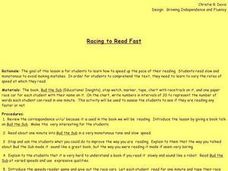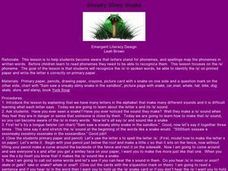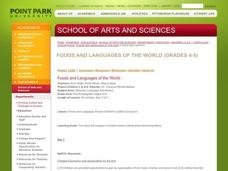Curated OER
You Pick Your Own Book!
Students decide on which chapter book they would like to read. They read the book, discussing certain chapters to keep the ending of the story a secret to slower readers. Each day they get into groups with students who are reading the...
Curated OER
"Whaaa" Said The Baby"
Young scholars recognize phonemes that correspond with the letters in the alphabet. They focus on identifying the short a, /a/ sound. They examine the way their mouths move when making the short a sound mimicking a baby's cry. In given...
Curated OER
Reading is Fun
Students explore the benefits and joys of reading. They review the reading comprehension strategy cross-checking. They then are introduced to the library and are encouraged to check out an independent book they would independently...
Curated OER
Imagine This
Students practice visualizing as they read to aid comprehension. They then read a chapter in their history book and visualize what they read so that they can answer comprehension questions about the chapter.
Curated OER
ABC Bingo
Learners practice recognizing letters and phonemes. After the instructor reads a book emphasizing the sound each letter makes, students play letter recognition games. Through matching and listening games, they recognize the letter from...
Curated OER
Slithering Snake
Students identify the grapheme and phoneme for S. They practice writing the letter S and through listening activities, discriminate the phoneme /s/. They associate the phoneme /s/ with its letter representation and identify it in various...
Curated OER
Racing to Read Fast
Students identify and interpret how to speed up the pace of their reading. Then they read slow and monotonous to avoid making mistakes. Students also read to comprehend the text that they need to identify to vary the rates of speed at...
Curated OER
Express Yourself
Young scholars listen the the phrase, "have a good day" spoken once with a happy expression and once with no expression and decide which one convinced them that the speaker wanted them to have a good day. They read, "Twinkle, Twinkle...
Curated OER
Summarization Know How
Students summarize a piece of text nonfiction text. After reviewing the correct way to read and summarize, students independently read a nonfiction article. They write a summary paragraph using the process outlined by the instructor...
Curated OER
Sneaky Slimy Snake
Students complete a variety of activities related to the /s/ phoneme. As a class they recite a tongue twister, then trace and write the letter S. Students then listen to word pairs and identify the word in each pair containing the /s/...
Curated OER
AC Filtering With Capacitors
Students investigate the properties of capacitors and discover that capacitors block DC and filter AC. They discover the function of capacitors. Students differentiate between AC and DC power. They explore the role of resistors.
Curated OER
Mission: Project Rescue
Third graders explore animals and their habitats. Using the Internet, they gather information and determine which animal goes into which habitat. Students design travel containers to provide proper food, water and comforts for the animal.
Curated OER
Eddie the Elephant
Students need to practice sight words to become proficient readers. So it is very important for children to learn common correspondences. The phoneme for the letter "e" is practiced in this lesson.
Curated OER
Shiny Shells on the Shore
Students investigate how: A single phoneme, which is a vocal gesture in spoken words, can be represented by more than one grapheme. Also how a digraph is the combination of two letters that make one sound (there are both vowel and...
Curated OER
Vroom, Vroom, Vroom! Off We Go!
Young scholars practice sentences and short books to improve their fluency. They read practice sentences to model fluent reading. They review decoding strategies for unknown words including cross-checking. They read with their partner...
Curated OER
"Let's Get to the Point--Summarize!"
Learners get rid of unnecessary information. They pick out the most important information. Students write a sentence that covers everything that is important information from the passage. They fill out a check list to check behind...
Curated OER
Creating Images to Fill in the Holes
Students encounter the effective method to improve their comprehension of visualizing, or using the text on the page to create a mental image. They increase comprehension by essentially digesting the text in two different...
Curated OER
Eeeee -- It's a Mouse!
Pupils recognize the long "e" sound, and identify it in spoken words by learning letter symbols. Students participate in role playing and tongue twisters to learn the long "e" sound. By learning phenomes, pupils are taking the first...
Curated OER
Cat Nap
Students identify and interpret the concept of the vowel /a/ and recognize it in words and illustrations. They also practice writing both upper and lower case A on writing paper. Finally, students name pictures and circle the pictures...
Curated OER
Jump on the Expression Express
Students read for comprehension and practice reading fluently with expression. After a reading demonstration, and discussing how to recognize punctuation, students read given stories to a partner. Students rate their partner's...
Curated OER
Food and Languages of the World
Students examine Japanese culture. In this multicultural lesson plan, students taste rice crackers and create Japanese fans from paper and paint.
Curated OER
Food and Languages of the World
Students engage in creative bead making while discussing Africa. In this diversity and arts lesson, students create African necklaces while being introduced to the African culture.
Curated OER
The Rainforest Walk
Fourth graders research the characteristics and inhabitants of the rainforest. They demonstrate their ability to communicate using e-mail and create a class presentation of their research.
Curated OER
Route 66
Students research the Internet to locate information about the Route 66 Festival. They focus on the history of the route in Illinois and create a web page of information.

























